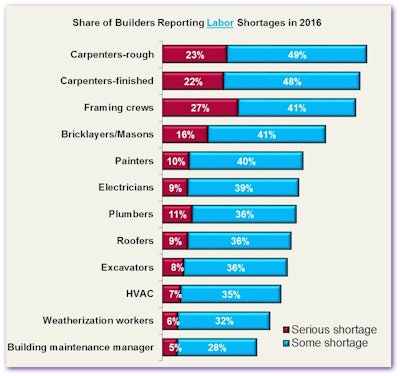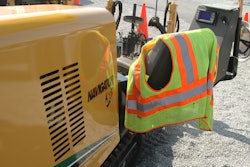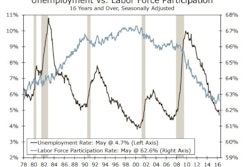
A National Association of Home Builders (NAHB) survey of single-family builders conducted in June 2016 shows that shortages of labor and subcontractors have become more widespread than they were a year ago.
The survey consisted of special questions on labor and subcontractor availability that NAHB has periodically added to the instrument for the monthly NAHB/Well Fargo Housing Market Index. The questions have covered nine key trades in a consistent way since 1996. Averaged across the nine trades, the share of builders reporting either some or a serious shortage has skyrocketed from a low of 21% in 2012, to 46% in 2014, 52% in 2015 and now 56% in 2016.
The nine-trade average shortage was somewhat higher in the late 1990s, but that was a period when real GDP was growing at 4% a year and annual housing starts were hovering within a narrow band around 1.5 million. The current labor shortage seems particularly severe relative to housing starts, which still have only partially recovered from the 2007-2009 downturn, to an annual rate of about 1.1 million.
The shortages are also particularly severe for basic skills like carpentry, which are needed during the construction of any home. For example, in the 2016 survey, 72% of builders reported a shortage (either serious or some) of construction workers willing and able to do rough carpentry.
The shortages of subcontractors are more widespread. For every one of the 12 trades covered in the 2016 survey (the 12 categories were recommended by the Home Builders Institute), more builders reported a shortage of subcontractors than reported a shortage of labor they employ directly.
For example, 78% of builders reported a shortage (either serious or some) of rough carpentry subcontractors, compared to 72% who reported a shortage of rough carpenters they directly employ; 67% reported a shortage of bricklayer/masonry subcontractors, compared to 57% for bricklayers and masons the directly employ; and so on.
As a previous study has shown, on the typical single-family home, three-quarters of the construction work is done by subcontractors. A shortage of subcontractors can therefore be very serious, and ignoring it gives an incomplete picture of the problem’s severity.
The most common effects of the shortages have been causing builders to pay higher wages/subcontractor bids (reported by 75% of builders) forcing them to raise home prices (68%) and making it difficult to complete projects on time (58%).
While the shortages appear widespread, conditions vary across the country. Not all builders in NAHB’s 2016 survey reported shortages. Some even wrote in specific comments that they were not seeing any shortage of labor in the markets where they currently build.
For more details — including the survey questionnaire, changes in labor and subcontracting costs, and the completely history of responses to each question — consult the full report.

















